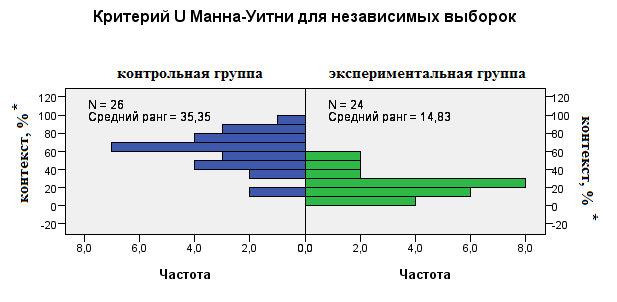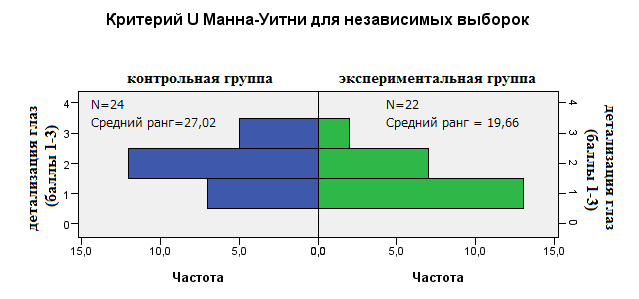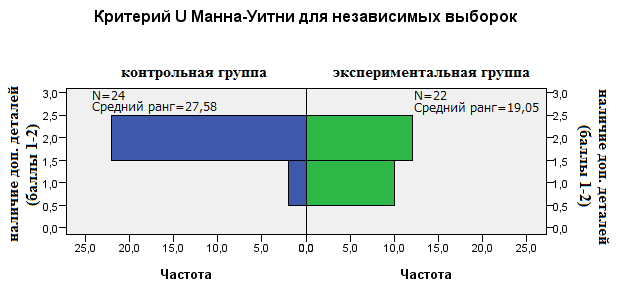Клиническая и специальная психология
2014. Том 3. № 4
ISSN: 2304-0394 (online)
Восприятие эмоций по лицевой экспрессии детьми с расстройствами аутистического спектра
Аннотация
Общая информация
Ключевые слова: восприятие эмоций, расстройства аутистического спектра, аутизм, восприятие эмоций по лицевой экспрессии, пространственное восприятие
Рубрика издания: Эмпирические исследования
Тип материала: научная статья
Для цитаты: Дрогунова А.В., Каримулина Е.Г. Восприятие эмоций по лицевой экспрессии детьми с расстройствами аутистического спектра [Электронный ресурс] // Клиническая и специальная психология. 2014. Том 3. № 4. URL: https://psyjournals.ru/journals/cpse/archive/2014_n4/Drogunova_Karimulina (дата обращения: 27.04.2024)
Полный текст
Введение
Понятие «социальный интеллект», введенное ещё в 1920 году Э. Торндайком, должно было подчеркнуть значение понимания людьми друг друга и их эмоций для адаптации человека в обществе [1]. Важным импульсом в понимании эмоций других людей стала работа Джона Майера и Питера Саловэя (1990 год), был введен термин коэффициент «эмоционального интеллекта».
Интерес к проблеме понимания эмоций и ментального состояния других людей продолжает возрастать [1]; [5]. Об этом говорит большое количество работ, посвящённых новому теоретическому направлению - модели психического [11]. Снижение социального интеллекта и понимания эмоций другого рассматривается во взаимосвязи другими неврологическими и психическими нарушениями [10]; [12]; [22].
Нарушение понимания эмоций других людей является одним из центральных проявлений расстройств аутистического спектра (РАС) [6]; [7]; [24]. Изучение взаимосвязи когнитивных способностей и восприятия эмоций на выборке детей с РАС представляет большой интерес для выявления основных закономерностей нарушений механизма понимания другого.
Новизна данного исследования заключается в рассмотрении восприятия лицевой экспрессии как решения задачи на зрительно-пространственный анализ и синтез.
Целью данной работы является изучение особенностей восприятия эмоциональных экспрессий и их соотносительности (связи) с характеристиками зрительно-пространственного восприятия у детей с РАС.
Гипотеза исследования
В картине РАС можно обнаружить единый радикал в нарушениях восприятия эмоций по лицевой экспрессии и специфических отклонениях в характеристиках зрительно-пространственного восприятия. А именно - дети с РАС будут значимо отличаться от детей контрольной группы по
1) эффективности распознавания эмоции по лицевой экспрессии вне контекстных ситуаций;
2) эффективности распознавать эмоции в контексте;
3) качественным характеристикам выполнения зрительно-пространственных заданий.
Помимо доказанных во многих исследованиях нарушений социального взаимодействия, дети с РАС отличаются атипичной обработкой зрительной [2]; [16]; [18] и зрительно-пространственной информации. Таким образом, если существует связь успешности выполнения зрительно-пространственных заданий с эффективностью распознавания эмоций (дети с РАС при более успешном выполнении зрительно-пространственных заданий легче распознают эмоции, чем дети с РАС, не справляющиеся со зрительно-пространственными заданиями), то можно утверждать, что у детей с РАС имеет место нарушение когнитивного компонента оценки эмоций по лицевой экспрессии.
Экспериментальная база
Исследование проводилось на базе следующих учреждений:
1. ГБОУ ОЦПМСС ЦОУО ДОгМ, отделение «Тверское»;
2. ГБОУ ЦО №1811;
3. ГБОУ ДС комбинированного вида №288;
4. ЦПМССДиП ГБОУ ВПО МГППУ «Кашенкин Луг».
Описание выборки
В исследовании приняли участие дети с диагнозом РАС. Критерии отбора:
• отсутствие специфических речевых дефектов, препятствующих речевому общению;
• понимание и удержание речевой инструкции;
• мнение специалистов, непосредственно работающих с детьми (в случае несоответствия поведения ребёнка имеющемуся диагнозу и возможном пересмотре, дети из выборки исключались).
Таблица 1. Характеристика испытуемых по полу
|
|
мальчики |
девочки |
всего |
|
Дети с РАС |
22 |
2 |
24 |
|
Контрольная группа |
24 |
2 |
26 |
Таблица 2. Характеристика испытуемых по возрасту
|
|
5,5 лет |
6 лет |
7 лет |
8 лет |
9 лет |
|
Дети с РАС |
6 |
10 |
4 |
2 |
2 |
|
Контро льная группа |
4 |
16 |
3 |
1 |
2 |
Таблица 3. Методики обследования и количество испытуемых
|
|
Emotions |
Копирование фигуры |
Нарисуй эмоцию |
|
Дети с РАС |
24 - 100% |
24 - 100% |
24 - 100% |
|
Контрольная группа |
26 - 100% |
24 - 92,3% |
24 - 92,3% |
Используемые методики
Emotions
Методика состоит из 48 фотографий людей, испытывающих различные эмоции. Она использовалась для выявления понимания уровня эмоций по лицевой экспрессии и по контексту.
В данном исследовании карточки с изображениями людей делились на две группы:
• карточки, где для понимания эмоций достаточно было рассмотреть лицо;
• карточки, где для понимания эмоций нужно было также правильно понять контекст ситуации.
При предъявлении контекстных карточек испытуемого также спрашивали о том, что происходит на картинке (чтобы удостовериться, что правильное понимание эмоции не случайно).
Оценка выполнения методики. За каждый правильный ответ (соответствующий словам, имеющимся в инструкции или являющийся их синонимом) испытуемому ставится 1 балл.
Баллы суммируются по группам.
Поскольку некоторые испытуемые переутомлялись или по иным причинам было невозможно предъявить все карточки, вычислялся процент правильного выполнения для каждой из групп.
Эмоция на лице («Закончи рисунок»)
Испытуемым раздавали бланки с напечатанными на них изображениями овалов лиц (методика Е. Д. Хомской) без деталей лица. Задачей испытуемого было дорисовать лицо с учетом подписанного под ним названия эмоции.
Оценка выполнения методики проводилась по ряду характеристик.
1) Адекватность - с помощью экспертной оценки оценивалось, насколько рисунки эмоций соответствовали подписанным эмоциям. Баллы - от 1 до 3.
2) Наличие всех основных частей лица (глаза, нос, рот). Баллы - от 1 до 3.
3) Детализация глаз. Баллы - от 1 до 3.
4) Наличие дополнительных деталей (например, слёзы при горе, какие-либо предметы или другие детали, не относящиеся к вышеописанным частям лица и отражающие при этом эмоцию). Баллы - от 1 до 2.
5) Общее впечатление от работы (экспертная оценка работы от 1 до 5).
Таким образом, выделены две итоговые оценки работы.
1) Суммарный балл по первым четырём шкалам. Чем выше - тем лучше выполнение.
2) Общее впечатление от работы. Чем выше балл - тем лучше общее впечатление о выполнении задания.
Копирование фигуры Рея-Остерица
Критерии оценки:
1) стратегия копирования (целостная, фрагментарная, хаотическая и фрагментарно-хаотическая);
2) выраженность ошибок разных типов (топологические, координатные и метрические), баллы от 1 до 4;
3) пропуск деталей, баллы от 1 до 3.
Баллы по каждому виду ошибок и по шкале «Пропуск деталей» составляют суммарный балл. Чем ниже суммарный балл, тем лучше выполнение задания.
Результаты исследования
Для статистической оценки данных использовались непараметрический критерий Манна-Уитни для двух независимых выборок и коэффициент корреляции Спирмена. Статистическая обработка данных производилась с помощью программы SPSS версии 22.0.
Разница между группами в выполнении методики «Копирование фигуры» отсутствует (рис. 1).

* - процент успешного распознавания эмоций на лице вне контекста
Рис. 1. Восприятие эмоций на лице вне контекста
Существует статистически значимые различия между группами в выполнении методики «Emotions». Дети с РАС распознают как отдельно эмоции по лицевой экспрессии, так и эмоции в контексте хуже, чем испытуемые контрольной группы.

* - процент успешного распознавания эмоций на контекстных картинках
Рис. 2. Восприятие эмоций в контексте
Данные результаты соотносятся с выводами многих исследований и показывают наличие трудностей в распознавании эмоций у детей с РАС.
Восприятие эмоций по лицевой экспрессии и пространственное восприятие
Таблица 4. Связь количества пространственных ошибок и распознавания эмоций по лицевой экспрессии
|
|
Связь пространственных ошибок и опознавание простых стимулов |
Связь пространственных ошибок и опознавание эмоции в контексте |
|
Дети с РАС |
-0,151 |
-0,541** |
|
Контр. группа |
-0,04 |
-0,089 |
** - p≤0.01
В группе детей с РАС выявлена статистически значимая связь между суммой пространственных ошибок и распознаванием эмоций в контексте. В контрольной группе такая связь отсутствует.
Восприятие эмоций и виды пространственных ошибок
Для более точного понимания связи распознавания эмоций и зрительнопространственных ошибок были сопоставлены особенности восприятия эмоций с каждым из типов ошибок в отдельности.
Таблица 5. Связь пространственных ошибок по видами распознавания эмоций на лице
|
|
топол |
координат |
метрическ |
пропуск.дет |
|
Дети с РАС |
-0,034 |
-0,352 |
-0,350 |
-0,332 |
|
Конт.группа |
-0,187 |
-0,303 |
-0,081 |
-0,120 |
Связь между пространственными ошибками по типам и восприятием эмоций по лицевой экспрессии вне контекста отсутствует как в экспериментальной, так и в контрольной группах.
Таблица 6. Связь пространственных ошибок по видам и распознавания эмоций в контексте
|
|
топол. |
координат |
метрическ. |
пропуск. дет. |
|
Дети с РАС |
-0,507* |
-0,365 |
-0,662** |
-0,06 |
|
Контр. группа |
-0,102 |
0,313 |
-0,328 |
0,143 |
* - p≤0.05
** - p≤0.01
В группе детей с РАС существует связь между количеством топологических и метрических ошибок и восприятием эмоций в контексте, в контрольной группе данные связи отсутствуют. Таким образом, были получены результаты, свидетельствующие о сложной структуре восприятия и оценки эмоций у детей с РАС. Оценка эмоций в контексте (т.е. понимание эмоций по модели эмоционального интеллекта Майера-Саловея) затруднена у детей с РАС, в то же время вне контекста оценка эмоций является более эффективной и не связана с характеристиками зрительно-пространственного восприятия.
Части лица (методика «Нарисуй лицо») и восприятие эмоций
Сравнение двух выборок показало отсутствие разницы по параметрам «адекватность рисунка» (изображение эмоций), «детализация рта» и суммарному баллу за пробу.
Однако обнаружилась разница в следующих показателях (рис. 3-5):
1. присутствие всех частей лица;
2. детализация глаз;
3. наличие дополнительных деталей.
По всем этим показателям баллы у детей с РАС ниже. В их рисунках чаще отсутствует какая-либо часть лица, эмоции с помощью глаз передаются с меньшей выраженностью, чаще отсутствуют дополнительные детали.

U=156
Uкр = 158, p≤0.01
Рис. 3. Присутствие всех частей лица

U=179,5
Uкр = 188, p≤0.05
Рис. 4. Детализация глаз

U=166
Ukp = 188, p≤0.05
Рис. 5. Наличие дополнительных деталей
Качественный анализ процедуры эксперимента
Во время проведения исследования были замечены некоторые особенности.
1. При выполнении заданий с карточками Emotions дети с более выраженными аутистическими чертами быстро истощались, демонстрировали выраженные негативные аффективные реакции. Если испытуемые из контрольной группы не справлялись с вопросом, то негативный аффект был связан с трудностями распознавания или вовсе не наблюдался, а вот часть испытуемых из экспериментальной группы явно уставала уже на третьей карточке (17 из 24). На первый план выступало заметное напряжение и утомление. Им объективно была сложна данная задача, требовавшая большей затраты ресурсов. Такой тип выполнения задания был свойственен испытуемым с сохранным интеллектом, хорошо справлявшихся с копированием фигуры и рисованием лиц, посещающим группы подготовки к школе и успешно усваивающим новые знания и навыки (счёт, письмо, чтение). Статистический анализ подтвердил значимость отличий двух выборок по параметру «Перегрузка во время задания».
2. Дети с РАС видели и смогли описать как отдельные объекты на картинке (это доказывали дополнительные вопросы, задаваемые ребёнку), так и лицо человека, однако единая картина понимания ситуации не складывалась. Т.е. детям не удавалось установить связь ситуации и экспрессии лица, что позволяет говорить о своеобразной фрагментарности восприятия. При последовательных указаниях экспериментатора на те или иные детали изображения у детей получалось встроить их в целостный сюжет и правильней интерпретировать эмоции
и их возможную причину. Данный факт имеет большое значение для проектирования коррекционной работы.
Обобщение результатов
Таблица 7. Обобщение результатов
|
Проба |
Выполнение |
|
|
Дети с РАС |
Контрольная группа |
|
|
Копирование фигуры |
Нет различий |
|
|
Emotions |
Значимо хуже |
|
|
Связь пространственных ошибок с опознаванием эмоции по лицу вне контекста |
Нет |
Нет |
|
Связь пространственных ошибок с опознаванием эмоции по лицу в контексте |
Топологические ошибки, метрические ошибки |
Нет |
|
Присутствие всех частей лица |
Реже |
|
|
Детализация глаз |
Хуже |
|
|
Наличие доп. деталей |
Реже |
|
|
Выполнение пробы Emotions |
Требует больше ресурсов |
|
Наиболее значимым результатом экспериментальной работы явилось то, что однозначного ответа о связи оценки эмоции по эмоциональной экспрессии и состоянием зрительно-пространственной функции получено не было. При значимо худшем результате с опознаванием эмоций по лицу вне контекста детьми с РАС связи между выполнением пространственных проб и пониманием эмоций собственно по лицу не обнаруживается.
В то же время при общей сохранности восприятия эмоций по лицу (будет правильнее сказать - умения связать определенное изменение лица с той или иной эмоцией), можно говорить о качественном своеобразии механизма оценки эмоции в группе детей с РАС. Используется меньше информации, передаваемой лицом: меньше внимания уделяется дополнительным деталям, выражению глаз.
Возникает вопрос о неоднородности вклада различных полушарий в процесс восприятия эмоций и о необходимости различать влияние фрагментарности восприятия на процесс распознавания эмоций.
Отдельно стоит отметить обнаруженную повышенные утомляемость и напряжение детей с РАС при решении задач на распознавание эмоций и обнаруживаемую относительную способность этих детей понять эмоцию в контексте и сохранность данной функции при наводящих вопросах.
Все эти данные, с одной стороны, позволяют продолжить исследования в направлении изучения механизмов компенсации распознавания эмоций, а с другой - уже сейчас могут использоваться для создания новых коррекционных методов, применимых как для детей с РАС, так и для детей условной нормы, испытывающих трудности в распознавании эмоций по зрительным стимулам.
Литература
- Лунева О.В. История исследования социального интеллекта (начало) // ЗПУ . 2008. №4. URL: http://cyberleninka.ru/article/n/istoriya-issledovaniya-sotsialnogo-intellekta-nachalo (дата обращения: 23.02.2015)
- Переверзева Д.С., Горбачевская Н.Л. Особенности зрительного восприятия у детей с расстройствами аутистического спектра // Современная зарубежная психология. № 2 / 2013
- Рычкова О.В., Холмогорова А.Б. Концепция «социального мозга» как основы социального познания и его нарушений при психической патологии. Часть I. Концепция «Социальный мозг» — продукт современной нейронауки // Культурно-историческая психология. 2012. №3. С.86–94.
- Сакс О. Антрополог на Марсе. М.: АСТ, 2009.
- Adolphs R., Recognizing Emotion From Facial Expressions: Psychological and Neurological Mechanisms // Behavioral and Cognitive Neuroscience Reviews, March 2002 vol. 1 no. 1 21-62
- American Psychiatric Association (ed.). Diagnostic and statistical manual of mental disorders: DSM-IV-TR®. American Psychiatric Pub, 2000.
- American Psychiatric Association et al. The Diagnostic and Statistical Manual of Mental Disorders: DSM 5. – bookpointUS, 2013.
- Apperly I. A., Samson D., Humphreys G. W. Domain-specificity and theory of mind: evaluating neuropsychological evidence //Trends in cognitive sciences. 2005. Т. 9. №. 12. С. 572-577.
- Asperger H. Autistic psychopathy in childhood. Translated by UtaFrith, 1991.
- Bachara G. H. Empathy in learning disabled children //Perceptual and Motor Skills. 1976. Т. 43. №. 2. С. 541-542.
- Buitelaar J. K., Swaab, H., Van der Wees, M., Wildschut, M., & Van der Gaag, R. J. Neuropsychological impairments and deficits in theory of mind and emotion recognition in a non-autistic boy //European Child & Adolescent Psychiatry. 1996. Т. 5. №. 1. С. 44-51.
- Bloom E., Heath N. Recognition, expression, and understanding facial expressions of emotion in adolescents with nonverbal and general learning disabilities //Journal of Learning Disabilities. 2010. Т. 43. №. 2. С. 180-192.
- Bowers Dawn; Bauer, Russell M.; Heilman, Kenneth M. The nonverbal affect lexicon: Theoretical perspectives from neuropsychological studies of affect perception. // Neuropsychology, Vol 7(4), Oct 1993, 433-444
- Calder A.J., Burton A.M., Miller P., Young A.W., and Akamatsu S. A principal component analysis of facial expressions // Vision Research, Volume 41, Issue 9, April 2001, Pages 1179–1208
- Capps L., Yirmiya N., Sigman M. Understanding of Simple and Complex Emotions in Non‐retarded Children with Autism //Journal of Child Psychology and Psychiatry. 1992. Т. 33. №. 7. С. 1169-1182.
- Dakin S., Frith U. Vagaries of Visual Perception in Autism // Neuron, Vol. 48, 497–507, November 3, 2005
- Dapretto M., Davies M.S., Pfeifer J.H., Scott A.A., Sigman M., Bookheimer S.Y., Iacoboni M. Understanding emotions in others: mirror neuron dysfunction in children with autism spectrum disorders //Nature neuroscience. 2005. Т. 9. №. 1. – С. 28
- Davies S., Bishop D., Manstead A.S., Tantam D. Face perception in children with autism and Asperger's syndrome //Journal of Child Psychology and Psychiatry. 1994. Т. 35. №. 6. С. 1033-1057.
- Dawson, G., Webb, S. J., Carver, L., Panagiotides, H., &McPartland, J. Young children with autism show atypical brain responses to fearful versus neutral facial expressions of emotion //Developmental science. 2004. Т. 7. №. 3. С. 340-359.
- Dimitrovsky L., Spector H., Levy-Shiff R., Vakil E. Interpretation of facial expressions of affect in children with learning disabilities with verbal or nonverbal deficits //Journal of Learning Disabilities. 1998. Т. 31. №. 3. С. 286-292.
- Ekman P. Facial expression and emotion //American Psychologist. 1993. Т. 48. №. 4. С. 384.
- Gur R. C., Erwin R. J., Gur R. E., Zwil A. S., Heimberg C. & Kraemer H.C. Facial emotion discrimination: II. Behavioral findings in depression //Psychiatry research. 1992. Т. 42. №. 3. С. 241-251.
- Happe F. Studying Weak Central Coherence at Low Levels: Children with Autism do not Succumb to Visual Illusions. J. Child Psychol. Psychiat. Vol. 37, No. 7, pp. 873-877, 1996.
- ICD-10 Version:2010, http://apps.who.int/classifications/icd10/browse/2010/en
- ICD-11 Beta Draft, http://apps.who.int/classifications/icd11/browse/l-m/en
- Kanner L. Authistic disturbances of affective contact. Nervous Child. 1943;2:217–250.
- Lonare A., Jain S.V. A Survey on Facial Expression Analysis for Emotion Recognition.
- Mahjouri S., Lord C.E. What the DSM-5 portends for research, diagnosis, and treatment of autism spectrum disorders //Current psychiatry reports. 2012. Т. 14. №. 6. С. 739-747.
- Sackeim H. A., Gur R. С. Lateral asymmetry in intensity of emotional expression. Neuropsychologia, 1978, v. 16, No. 4, p. 473—483
- Vasey M.W., MacLeod C. Information-processing factors in childhood anxiety: A review and developmental perspective // Neuropsychology, Vol 7(4), Oct 1993, 433-444
- Wolff J. J. et al. Differences in white matter fiber tract development present from 6 to 24 months in infants with autism //American Journal of Psychiatry. 2012. Т. 169. №. 6. С. 589-600.
Информация об авторах
Метрики
Просмотров
Всего: 3154
В прошлом месяце: 9
В текущем месяце: 14
Скачиваний
Всего: 1685
В прошлом месяце: 5
В текущем месяце: 5